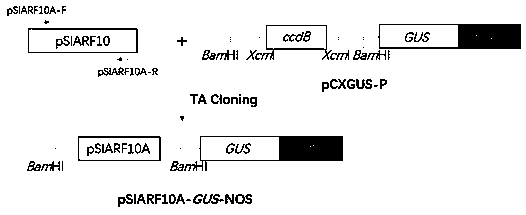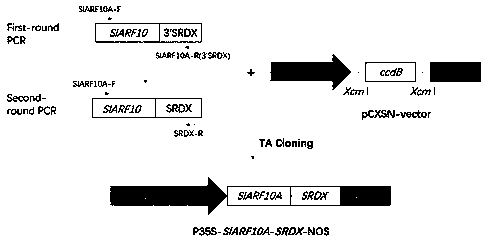Seedless tomato with characteristics of regular cracks and bright color, and breeding method thereof
A bright-colored, tomato technology, applied in the field of plant genetic engineering, can solve the problems of single gene function loss homologous gene function compensation failure, high coding sequence homology, gene function redundancy and other problems, so as to overcome the inhibition effect is not significant. Problems, simple inheritance of offspring, the effect of vigorous growth
- Summary
- Abstract
- Description
- Claims
- Application Information
AI Technical Summary
Problems solved by technology
Method used
Image
Examples
Embodiment 1
[0031] Example 1 Tomato Gene SlARF10A Promoter cloning and GUS histochemical staining analysis
[0032] (1) SlARF10A Cloning of gene promoter
[0033] Using CTAB method (RTG2405-01, Zhongke Tairui) to extract tomato genomic DNA, according to SEQ ID NO.3 pSlARF10A Nucleotide sequence, design primers pSlARF10A -F and pSlARF10A -R uses the extracted genomic DNA as a template to pSlARF10A -F (forward primer) and pSlARF10A -R (reverse primer) is the primer for gene SlARF10A The amplification.
[0034] The primer sequence is as follows:
[0035] pSlARF10A -F: 5’- CAATTTACATATACAACACATGCCTCA-3’
[0036] pSlARF10A -R: 5’- GCTAATCCAATAGTTTTTCCCCTTC-3’
[0037] P CR amplification system: high-fidelity amplification enzyme P rime STAR HS (R010A, TaKaRa) 0.25 μL, 5× P rimeSTAR Buffer (Mg 2+ P lus) 5 μL, forward primer (10 μM) 0.5 μL, reverse primer (10 μM) 0.5 μL, template (DNA) 1 μL, dNT P (2.5mM) 2μL, sterile ddH 2 Make up O to 25μL.
[0038] Reaction procedure: pre-denaturation 95℃, 5m...
Embodiment 2
[0059] Example 2 Tomato SlARF10A-SRDX Fusion gene cloning and Agrobacterium-mediated genetic transformation
[0060] (1) SlARF10A-SRDX Cloning of Fusion Fragments
[0061] Take the Micro Tom tomato mixed sample (leaf, flower and fruit) as the material, TRIzol™ Plus RNA PurificationKit (12183555, Invitrogen™), follow the instructions to extract total tomato RNA, and use DNase I (18047019, Invitrogen™) to remove residual trace DNA , And use a spectrophotometer to determine the concentration of RNA for use.
[0062] Take about 2.0μg tomato total RNA, use P rimeScri p t II first-strand cDNA synthesis kit (6210A, Takara), and follow the instructions to synthesize the first strand of cDNA.
[0063] According to the tomato shown in SEQ ID NO.1 SlARF10A Gene sequence, design specific primers SlARF10A -F, SlARF10A- 3’SRDX- R (without termination password) and SRDX -R. Use cDNA as a template to SlARF10A -F (forward primer) and SlARF10A - 3’SRDX- R (reverse primer) is the primer for th...
Embodiment 3
[0102] Example 3 Tomato SlARF10B-SRDX Cloning of fusion gene and genetic transformation mediated by Agrobacterium
[0103] (1) SlARF10B-SRDX Cloning of Fusion Fragments
[0104] Take the Micro Tom tomato mixed sample (leaf, flower and fruit) as the material, TRIzol™ Plus RNA PurificationKit (12183555, Invitrogen™), follow the instructions to extract total tomato RNA, and use DNase I (18047019, Invitrogen™) to remove residual trace DNA , And use a spectrophotometer to determine the concentration of RNA for use.
[0105] Take about 2.0μg tomato total RNA, use P rimeScri p t II first-strand cDNA synthesis kit (6210A, Takara), and follow the instructions to synthesize the first strand of cDNA.
[0106] According to the tomato shown in SEQ ID NO.3 SlARF10B Gene sequence, design specific primers SlARF10B -F, SlARF10B- 3’SRDX- R (without termination password) and SRDX -R. Use cDNA as a template to SlARF10B -F (forward primer) and SlARF10B - 3’SRDX- R (reverse primer) is the primer ...
PUM
 Login to View More
Login to View More Abstract
Description
Claims
Application Information
 Login to View More
Login to View More - R&D Engineer
- R&D Manager
- IP Professional
- Industry Leading Data Capabilities
- Powerful AI technology
- Patent DNA Extraction
Browse by: Latest US Patents, China's latest patents, Technical Efficacy Thesaurus, Application Domain, Technology Topic, Popular Technical Reports.
© 2024 PatSnap. All rights reserved.Legal|Privacy policy|Modern Slavery Act Transparency Statement|Sitemap|About US| Contact US: help@patsnap.com










